 |
| Category: Badges |

|
|
|
|
|
|
3 versions of the
history of the "Rising Sun" General Service badge |
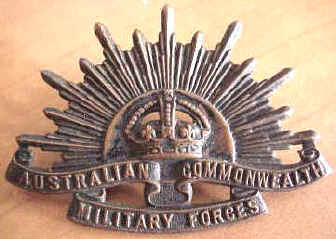 |
 |
| As discussed elsewhere the more popularly
accepted version of the "birth" of the Rising Sun Badge was
Version 1 below. However there are many people who support one or the
other of the other versions. |
| Version
1. SOUTH AUSTRALIAN
ORIGIN THEORY.
The famous Rising Sun Badge, selected as the
Army's General Service badge in 1902 but now the badge of the army,
originated in South Australia. The original concept, a collection of
bayonets and sword bayonets of the NSW Alexander Henry sword &
socket style, radiating from a crown, was designed as a trophy. The
initial drawing was done by Major J M Gordon, of the South Australian
Permanent Artillery in 1893.The working drawing for the trophy was
called 'Australia - Rising Sun'. It was used as the General Service
badge of the Army in 1914-18 with the words Australian
Commonwealth Military Forces. More
details. |
Version
2. NEW SOUTH
WALES ORIGIN THEORY. Another
popular theory relating to the origin of the Rising Sun badge involves
the badge of the 6th NSW Volunteer Infantry Regiment (Australian
Rifles). This Unit was formed in 1896 and the Adjutant was the aforesaid
Captain Cox-Taylor.
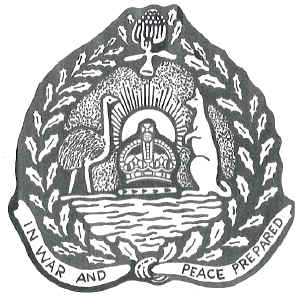
|
The Commanding
Officer of the 1st Battalion, Australian Commonwealth (Horse), was
Lieutenant Colonel J.S. Lyster. Cox-Taylor said that Lyster asked
him to design a badge for the 1st Battalion, Australian
Commonwealth (Horse).
He did so using the Rising
Sun emblem in the centre of the badge of the 6th NSW
Volunteer Infantry Regiment, (see left)
which he had also designed. Cox-Taylor was a draughtsman.
Mr. Bill Harris, who was Orderly
Room Clerk in the 1st Battalion, Australian Commonwealth Horse,
NSW Squadron, said that he had prepared the final drawing of the
badge at the direction of Cox-Taylor. |
The
theme of the design was the Rising Sun over the Crown of the Empire, on
which it never set. Mr. Harris said that Cox-Taylor was anxious to
complete the badge drawing
so that the badge could be produced before embarkation of the 1st
Battalion, Australian Commonwealth Horse, for South Africa.
If, as claimed, the badges were issued to the Queensland Squadron of the
1st Battalion, Australian Commonwealth Horse before they left Brisbane on 26th January 1902, then the issued badge
could not have been the 'General Hutton Badge'. Major General Hutton did not arrive in Melbourne to take up
his appointment as Commander-in-Chief of the Australian Commonwealth Military Forces, until 29th January 1902.
As the Queensland Squadron left Brisbane three days before General Hutton's arrival in Melbourne, the issued badge
would have been that of Captain Cox-Taylor. However, there is no known
documentation to prove that the badges were issued before embarkation for Sydney.
General Hutton had been 'on the job' for 20 days before the 1st Battalion
ACH left Sydney for the Boer War in South Africa, which gave him time (although limited) to organise the selection process and manufacture of a badge before embarkation.
General Hutton asked his Staff Officers for design suggestions for the ACH badge. Captain Cox-Taylor's design based
on the 6th Regiment NSW Volunteer Infantry badge, may have been submitted to General Hutton for consideration.
Some wording from The Australian Army Slouch Hat and
Rising Sun badge by Rick Grebert |
Version
3. NEW SOUTH
WALES ORIGIN THEORY (b)
Another version of Captain Cox-Taylor's involvement in the original Rising Sun badge design was told by
Mr. Frank Rose. Mr. Rose was an Acting Sergeant in A Squadron, 1st Battalion
ACH, at Moore Park Camp in Sydney. He remembered Colonel Lyster arriving one morning "In a bit of a flurry".
Colonel Lyster said to Captain Cox-Taylor and others, "We have no Regimental badge, and we are
the first Commonwealth Force to go abroad". He said that he had spoken to
General Hutton at Victoria Barracks in Sydney (General Hutton was in Sydney
from Melbourne, preparing for the despatch of the 1st Battalion ACH to South Africa). Hutton rejected Cox-Taylor's idea of a badge
using the Australian Coat-of-Arms theme, saying that the badge should be a
'badge for all time'.
Cox-Taylor then said that lie wanted a 'Rising Sun'.
Frank Rose said that he remembers Cox-Taylor arriving back at the Moore Park
Camp after a meeting with General Hutton at Victoria Barracks in Sydney. Cox-Taylor
found a 'Blazing Sun' at the rubbish tip, which he used as a short-cut between Victoria Barracks and Moore Park Camp.
The Blazing Sun was an 'advertisement for something'. Colonel Lyster
said later, "It looks like a Jap sign". Cox-Taylor folded the Blazing Sun in half and
said, "Make those tongues of flame out of swords and bayonets and
put a crown 'in the centre. Make a scroll for COMMONWEALTH FORCES and I think I can make something out of that".
Frank Rose said. "The credit for the Rising Sun badge design goes to
Cox-Taylor & to Cox-Taylor alone". Mr. Rose was putting his memory to the test 58 years after the events.
However it is reasonable to accept that Cox-Taylor did design a badge
from the Blazing Sun advertisement'.
- Evidence suggests that Cox-Taylor Submitted one (or more) badge designs for consideration.
- Were they rejected along with the 'flora and
fauna' designs that were submitted by other Staff Officers?
- Was one (or more) of Cox-Taylor's designs sent to the Melbourne die-sinkers along with General Hutton's Trophy of
Arms design, for final design sketches?
There is no known evidence that General Hutton's Trophy of Arms design
was the only one given to the Melbourne die-sinkers, on which they based their design sketches which General Hutton used to select tile badge
for the 1st Battalion, Australian Commonwealth Horse. Some
wording from The Australian Army Slouch Hat and Rising Sun badge by Rick
Grebert |
|
Are all of the above
wrong? |
| It is my personal opinion
that the people who have or still do promote these theories fail to look
far enough back into Australian Colonial military badge history and
other significant trends of the late 1800's.
I offer as some evidence: |
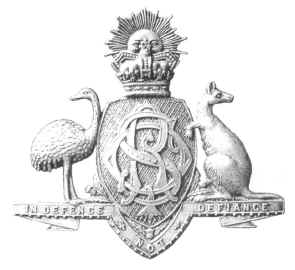 |
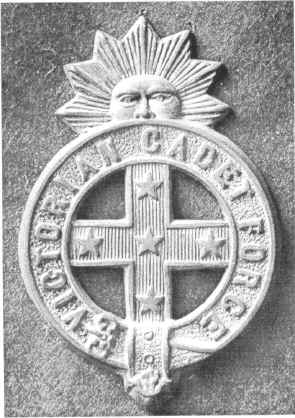
|
- This Queensland Scottish Regiment
badge (circa 1885) shows that the basic idea of a rising sun was not
new in 1902.
- So does this late 1890s Victorian
Cadet force badge >>>
When compared to the original
"Rising Sun" badge (below)
it is hard not to see the resemblance. |
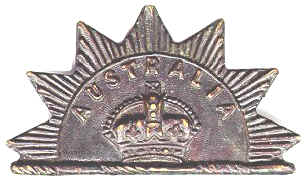 |
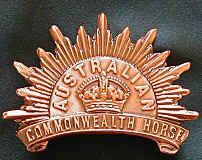
|
|
Original "Rising
Sun" badge |
2nd version
"Rising Sun" |
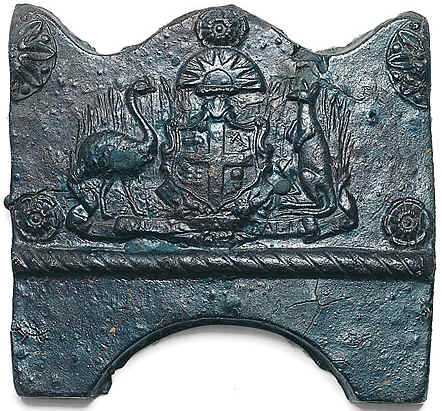 |
- A garden edging tile
circa 1900 which bears a design very similar to the NSW Coat of Arms.
- Some people claim that the
Rising Sun depicted is the fore-runner to the AIF Rising Sun
badge.
|
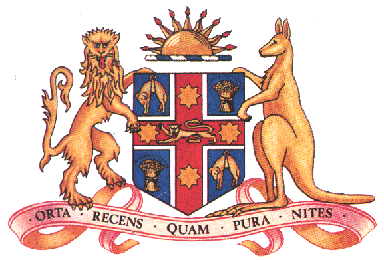 |
The NSW Coat of Arms was
granted by King Edward VII in Oct 1906. It features a shield containing
the badge of NSW together with wheat and sheep symbols on a blue
background. The shield is supported by a lion, representing England, and
a kangaroo, representing Australia. The
crest is a rising sun, representative of a newly rising country.
The Latin motto means "Newly risen, how bright thou shinest",
as shown by the rising sun. It also refers to the State's continuing
progress and development. |
|
The "Rising
Sun" on the Australian $100
note |
|
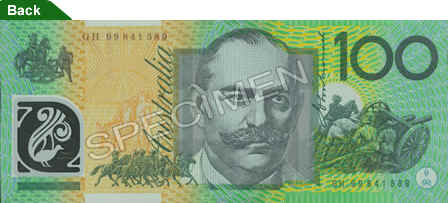
|
| Date of First
Issue |
15 May 1996 |
| Size |
65 x 158 mm |
| Signatures |
Top - EA Evans;
Bottom - I J Macfarlane |
| Front of Note Portrait |
Dame Nellie Melba (1861–1931) |
| Back of Note Portrait |
Sir
John Monash (1865–1931) |
| Designer |
Brian Sadgrove |
BACK
of the $100 note;
-
Portrait of Sir John Monash
Based on a photograph of Monash taken
in 1912. The original photograph is held by the National Library of
Australia in Canberra as part of the Monash Papers, and a print was
provided as reference for the designer.
-
Rising Sun Badge Based on reference material
supplied by the Australian War Memorial in Canberra. This badge, also
referred to as the Australian General Service Badge, but more commonly
known as the Rising Sun Badge, was adopted as the 'Australian Imperial
Force' badge and worn in World War I. Permission to use the badge was
provided by the Australian Army.
-
Cavalry Designer's interpretation of mounted
soldiers in World War I.
Soldier's and Cannon
Based primarily on a photograph taken
in 1917 titled Artillery in Noreuil Valley, showing the
batteries of the 2nd Australian Division attacking the Hindenberg Line.
The photograph is held by the State Library of NSW, which provided a
print as reference for the designer.
-
Simpson and Donkey Based on William Wallace Anderson's
statue called The Man with the Donkey, which is featured at the
shrine of Remembrance in Melbourne. Permission to use the image of the
statue was provided by the Shrine of Remembrance Trustees.
Taken from material provided by
the State Library of NSW.
|
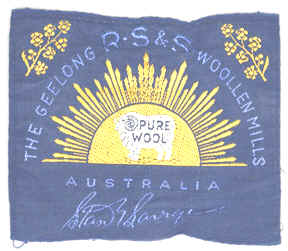 |
The Returned Soldiers' and
Sailors' Woollen and Worsted Co-operative Manufacturing Company Ltd was
formed in 1920 in Geelong, with the aim of producing fine quality
textiles. This label was probably taken from a travelling blanket.
Machine embroidered blue cotton label of the Geelong Returned Soldiers'
and Sailors' Woollen Mills. The label features golden wattle sprigs and
a gold 'rising sun' badge, at the centre of which is a white ram with
the words 'PURE WOOL' written on it. Around the top of the rising sun
are the words 'THE GEELONG R.S & S WOOLLEN MILLS', while below it is
the word 'AUSTRALIA' and the facsimile signature 'Stan Savige'. |
|